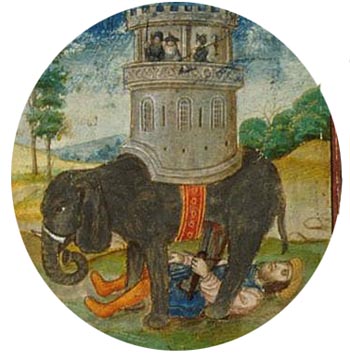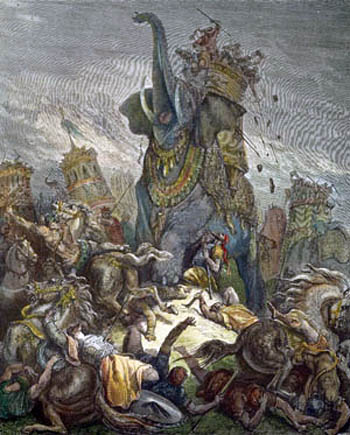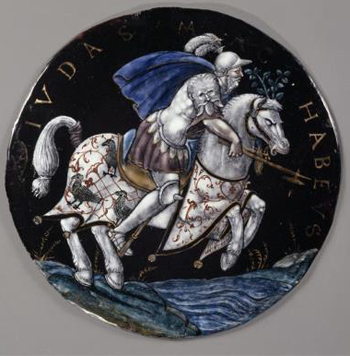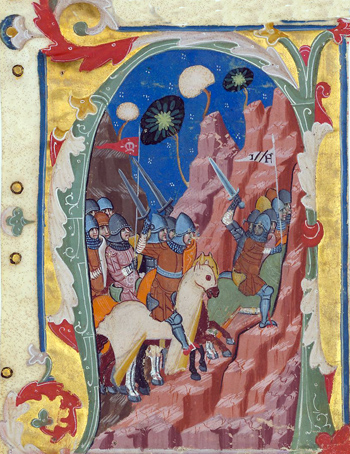Stories & Legends
 |
 |
 |
 |
 |
 |
 |
Miracles in the Crusades - 4
Maccabees Warriors Inspire the Crusaders
In the last article we showed how the Crusaders felt a close affinity to the Maccabees. Like the Crusaders at the Battle of Antioch, Judas Maccabeus and his men received heavenly help in two battles that ended in miraculous victories.
 But it was not just the victories of the Maccabees that inspired the Crusaders and the medieval man. They found in them examples of great courage in adversity, especially in the heroic deaths of two of the Maccabee warriors.
But it was not just the victories of the Maccabees that inspired the Crusaders and the medieval man. They found in them examples of great courage in adversity, especially in the heroic deaths of two of the Maccabee warriors.
There was already a long tradition of looking to the Maccabees who retook Jerusalem as precursors of the Catholic Crusaders who were fighting to retake the Holy Land. An early Church Father, St. Ambrose, considered at length and with high praise the deaths of Eleazar and Judas Maccabeus himself in his sermon De Officiis (On Duties).
The death of Eleazar in particular was well-known in the Middle Ages. His death in battle was seen as a prefigure of Christ's sacrifice of himself for mankind. The elephant in the story also made the scene a popular one to depict for artists.
Eleazar in the Battle of Beth Zachariah
As told in the First Book of Maccabees (Chap. 6), King Antiochus V was making what he thought would be a victorious march to Jerusalem. Meanwhile, Judas Maccabeus was besieging the citadel of Jerusalem trying to wrest it from the enemy. He ended the siege, however, in order to confront the King at the mountain pass at Beth Zachariah.
King Antiochus had decided to pursue the shock tactic of sending his strongest and most imposing forces to finish off the army of the Maccabees. Carrying his best generals into battle were elephants made drunk with the juice of grapes and mulberries in order to heighten their aggressiveness. Standing by every elephant was a thousand men in coats of mail and brass helmets and 500 horsemen set in order around every beast. And on the beasts were wooden towers with valiant men. (1 Mach 6:35-37)
 The soldiers wore shiny mail and flashed bronze shields, shouting thunderously into the echoing mountain sides to make the Seleucid Greek force appear indestructible and superhuman. It was a tactic of terror and having the desired effect.
The soldiers wore shiny mail and flashed bronze shields, shouting thunderously into the echoing mountain sides to make the Seleucid Greek force appear indestructible and superhuman. It was a tactic of terror and having the desired effect.
At this point, Eleazar, a younger brother of Judas Maccabeus, enters the narrative. When Eleazar noticed one of the enemy elephants was decorated with regal armor, he thought the King himself was being conveyed in the tower on its back. That elephant, the largest and most destructive of them all, was trampling hundreds of his valiant fellow warriors underfoot and causing terror in the troops. Then, to "deliver his people" and win an "everlasting name" of glory, he ran boldly into the enemy lines.
Approaching the elephant he single-handedly slaughtered or put to flight dozens of enemy soldiers who stood in his way. Then, placing himself beneath the underbelly of that elephant, he plunged the blade of his sword into it, knowing that this heroic act would bring about his own death.
Indeed, the animal fell and crushed Eleazar, who was thus buried in his own triumph. Although the King was not on that elephant and the Maccabees were forced to retreat to Jerusalem, his feat became a legend. He won an everlasting glory, for his name survived as a synonym of courage and willingness to sacrifice his life for his people.
The death of Judas Maccabeus
Judas Maccabeus also died a glorious death. In the Battle of Elasa in 160 BC, Judas set into battle against 20,000 with an army of only 3,000 men. Some of these men were desperate to turn back, but he persuaded one-third of them "to fight and die with glory rather than flee and bring shame on themselves."
 Leading his small band in a desperate charge on the enemy’s right flank, Judas killed a great number of Seleucids but failed in the crucial objective of killing their commander, General Bacchides. Instead, Judas met his death in the fighting on that rough terrain surrounding Jerusalem.
Leading his small band in a desperate charge on the enemy’s right flank, Judas killed a great number of Seleucids but failed in the crucial objective of killing their commander, General Bacchides. Instead, Judas met his death in the fighting on that rough terrain surrounding Jerusalem.
However, like Eleazar, he "found in death a place of greater glory than his triumphs had afforded." (St. Ambrose, De Officiis)
The death of Judas Maccabeus in 160 BC stirred the Jews to renewed resistance. After several additional years of war under the leadership of two other brothers of Judas, Jonathan and Simeon, Seleucid control of Judea was broken.
Maccabee & Crusader brotherhood
That the Crusaders felt a brotherhood with the Maccabees warriors is confirmed in chronicles of the Crusades. Caffaro describes Angels in Heaven receiving Crusaders who died during the siege of Antioch and giving them a place next to the Maccabees. (1)
 In his famous chronicle, Fulcher of Chartres went even further. In his prologue, he compared the deaths of the Crusader to the martyrdom of the Maccabees.(2)
In his famous chronicle, Fulcher of Chartres went even further. In his prologue, he compared the deaths of the Crusader to the martyrdom of the Maccabees.(2)
Raymond of Aguilers, chronicler of the First Crusade, also praises the courage of the Maccabees in going into battle time after time against great odds. But he goes on to argue that the Crusaders were worthier because they won victories against even greater odds:
"I dare say, if I were not modest, I would rate this battle above even the Maccabees war, because the Judas Maccabeus with 3,000 struck down 48,000 of his foes, while here 400 Christian knights routed 60,000 pagans.
"But we neither disparage the courage of Maccabees nor boast of the bravery of our knights. Rather, we proclaim God, once wonderful to Maccabees, was even more so to our army!" (3)
Continued

Eleazar killing the elephant
There was already a long tradition of looking to the Maccabees who retook Jerusalem as precursors of the Catholic Crusaders who were fighting to retake the Holy Land. An early Church Father, St. Ambrose, considered at length and with high praise the deaths of Eleazar and Judas Maccabeus himself in his sermon De Officiis (On Duties).
The death of Eleazar in particular was well-known in the Middle Ages. His death in battle was seen as a prefigure of Christ's sacrifice of himself for mankind. The elephant in the story also made the scene a popular one to depict for artists.
Eleazar in the Battle of Beth Zachariah
As told in the First Book of Maccabees (Chap. 6), King Antiochus V was making what he thought would be a victorious march to Jerusalem. Meanwhile, Judas Maccabeus was besieging the citadel of Jerusalem trying to wrest it from the enemy. He ended the siege, however, in order to confront the King at the mountain pass at Beth Zachariah.
King Antiochus had decided to pursue the shock tactic of sending his strongest and most imposing forces to finish off the army of the Maccabees. Carrying his best generals into battle were elephants made drunk with the juice of grapes and mulberries in order to heighten their aggressiveness. Standing by every elephant was a thousand men in coats of mail and brass helmets and 500 horsemen set in order around every beast. And on the beasts were wooden towers with valiant men. (1 Mach 6:35-37)

Eleazar won an everlansting name of glory with his bold feat
At this point, Eleazar, a younger brother of Judas Maccabeus, enters the narrative. When Eleazar noticed one of the enemy elephants was decorated with regal armor, he thought the King himself was being conveyed in the tower on its back. That elephant, the largest and most destructive of them all, was trampling hundreds of his valiant fellow warriors underfoot and causing terror in the troops. Then, to "deliver his people" and win an "everlasting name" of glory, he ran boldly into the enemy lines.
Approaching the elephant he single-handedly slaughtered or put to flight dozens of enemy soldiers who stood in his way. Then, placing himself beneath the underbelly of that elephant, he plunged the blade of his sword into it, knowing that this heroic act would bring about his own death.
Indeed, the animal fell and crushed Eleazar, who was thus buried in his own triumph. Although the King was not on that elephant and the Maccabees were forced to retreat to Jerusalem, his feat became a legend. He won an everlasting glory, for his name survived as a synonym of courage and willingness to sacrifice his life for his people.
The death of Judas Maccabeus
Judas Maccabeus also died a glorious death. In the Battle of Elasa in 160 BC, Judas set into battle against 20,000 with an army of only 3,000 men. Some of these men were desperate to turn back, but he persuaded one-third of them "to fight and die with glory rather than flee and bring shame on themselves."

Judas Maccabeus shown as
a valiant knight entering battle
However, like Eleazar, he "found in death a place of greater glory than his triumphs had afforded." (St. Ambrose, De Officiis)
The death of Judas Maccabeus in 160 BC stirred the Jews to renewed resistance. After several additional years of war under the leadership of two other brothers of Judas, Jonathan and Simeon, Seleucid control of Judea was broken.
Maccabee & Crusader brotherhood
That the Crusaders felt a brotherhood with the Maccabees warriors is confirmed in chronicles of the Crusades. Caffaro describes Angels in Heaven receiving Crusaders who died during the siege of Antioch and giving them a place next to the Maccabees. (1)

A medieval prayer book portrays the Maccabees dressed as medieval knight routing the Greek army
Raymond of Aguilers, chronicler of the First Crusade, also praises the courage of the Maccabees in going into battle time after time against great odds. But he goes on to argue that the Crusaders were worthier because they won victories against even greater odds:
"I dare say, if I were not modest, I would rate this battle above even the Maccabees war, because the Judas Maccabeus with 3,000 struck down 48,000 of his foes, while here 400 Christian knights routed 60,000 pagans.
"But we neither disparage the courage of Maccabees nor boast of the bravery of our knights. Rather, we proclaim God, once wonderful to Maccabees, was even more so to our army!" (3)
- Elizabeth Lapina, Warfare and the Miraculous in the Chronicles of the First Crusade, Pennsylvania State University Press, 2015, p. 105.
- Ibid, p. 106.
- Ibid., p. 113.
.
Posted April 24, 2019
Posted April 24, 2019


